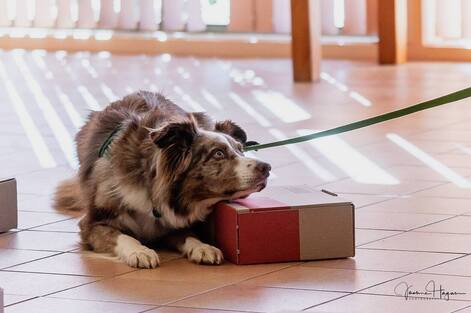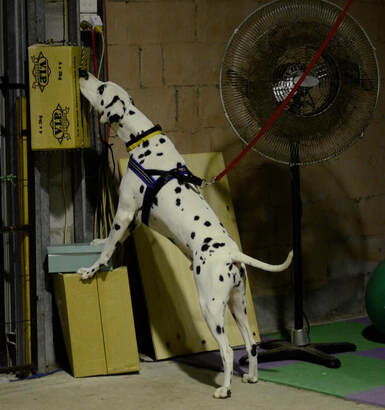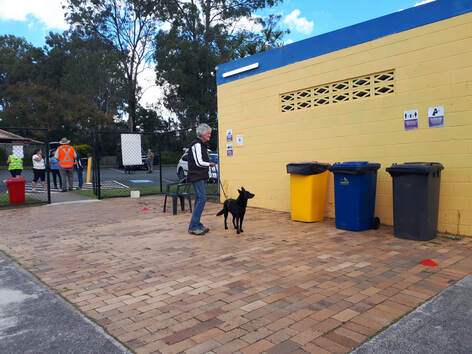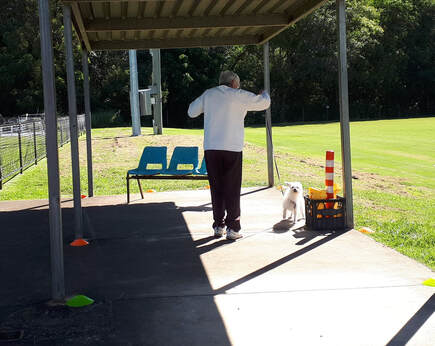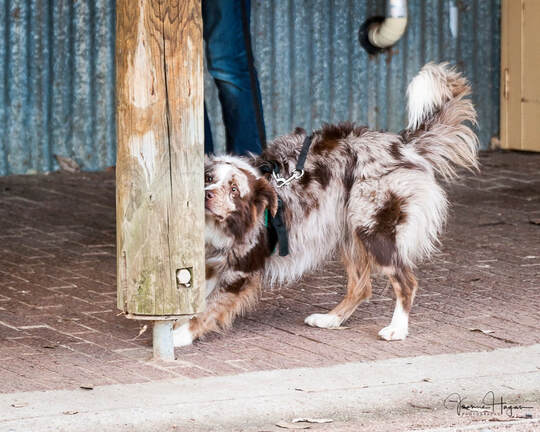Competitor's Briefing
INFORMATION PROVIDED TO COMPETITORS IN ADVANCE OF TRIAL
It is likely that the Club hosting the ANKC Scent Work trial will circulate information to competitors in advance of the trial. This may include information such as –
It is likely that the Club hosting the ANKC Scent Work trial will circulate information to competitors in advance of the trial. This may include information such as –
- Venue
- Arrangements for/location of parking and crating of dogs
- Area/s for toileting dogs
- Registration location and time and start times
|
COMPETITOR NUMBER AND RUNNING ORDER
Handlers will typically obtain their number at registration. The catalogue may be available at registration or may have been available online in advance of the trial. Be aware of your position in the running order so that you can start your preliminary preparation a couple of dogs before your turn. Your catalogue number must be worn on your person (normally on your chest or your upper arm) and visible to the judge and trial officials. VETTING Any entire bitches must be ‘vetted’ by a club official to ensure compliance with the ANKC rule: “Bitches in oestrum or showing a coloured discharge of any sort shall not be permitted to compete in trials, nor remain within the precincts of a trial.” WALK THROUGH A walk through may be conducted at the discretion of the judge. If conducted this may be a physical walk through or one available for viewing online. Apart from any such walk through, handlers must not enter any of the search areas, other than for the purpose of their actual searches. MARSHALLING AREA Once the trial gets under way, competitors will be called, in turn, first to the marshalling area. |
WARM UP BOXES
Warm up boxes may be provided and are likely to be located near the marshalling area. Competitors may use the warm up boxes when advised by the steward – typically after the competitor ahead of them has moved towards the search area. Use of the warm up boxes is optional. Handlers should not touch the odour boxes which will be clearly marked.
STAGING ROUTE
The route to the search area/s will be identified in some way (eg cones, tape), and stewards will direct you when to move on to the next staging point. You may need to wait at each staging point, until the competitor ahead of you has moved past that point.
Before reaching the search area (eg after leaving the penultimate staging point), ensure that your dog’s equipment is appropriately fitted and that you are organised for the search.
Warm up boxes may be provided and are likely to be located near the marshalling area. Competitors may use the warm up boxes when advised by the steward – typically after the competitor ahead of them has moved towards the search area. Use of the warm up boxes is optional. Handlers should not touch the odour boxes which will be clearly marked.
STAGING ROUTE
The route to the search area/s will be identified in some way (eg cones, tape), and stewards will direct you when to move on to the next staging point. You may need to wait at each staging point, until the competitor ahead of you has moved past that point.
Before reaching the search area (eg after leaving the penultimate staging point), ensure that your dog’s equipment is appropriately fitted and that you are organised for the search.
SEARCH AREA AND SEARCH
You will be greeted at the entry to the search area by a steward and the judge or steward will indicate to you the start line and the boundaries of the search area, and then invite you to commence the search when you are ready.
Remember to take your time, to allow your dog and yourself to take in the look (and for your dog the smell) of the search area. Also remember to implement the start line ritual that you have been practising.
It is essential that your dog crosses the start line within the boundaries which have been indicated to you. You will incur a fault if your dog goes around the side of the start line/around the markers defining the start line.
Searches are timed, and timing is taken into account in determining if the search has been completed within the maximum time allowed, and for placings. Timing starts when any part of your dog or any part of your body crosses the start line, so it is a good idea to set yourself up a little back from the start line when pausing before commencing the search.
The Time Steward may give you a 30 second warning – ie 30 seconds before the expiry of the time allowed for the search. They also may refrain from doing this if they think that doing so could distract the dog when he is close to the hide; or they may forget! A handler can also ask that no warning be given eg if they feel it could upset their dog. The absence of a 30 second warning does not invalidate the search outcome.
When you believe your dog has found the hide, you give an ‘Alert’ call. In Advanced and higher level classes, the handler must also give a ‘Finish’ call when they consider all hides have been located. For more on this see ALERT CALL. The judge will indicate whether your call is correct or incorrect.
You can then reward your dog (assuming he has alerted correctly) with food or a toy. You will incur a fault/s if you drop food, so be careful how you manage and dispense your food reward; a fault applies whether food is dropped on, near or away from the hide, but regardless of that it is recommended that you reward beside rather than above the hide. If you use a toy, it must be held by you throughout and cannot be thrown. Toys that make a noise cannot be used for reward purposes.
You will be greeted at the entry to the search area by a steward and the judge or steward will indicate to you the start line and the boundaries of the search area, and then invite you to commence the search when you are ready.
Remember to take your time, to allow your dog and yourself to take in the look (and for your dog the smell) of the search area. Also remember to implement the start line ritual that you have been practising.
It is essential that your dog crosses the start line within the boundaries which have been indicated to you. You will incur a fault if your dog goes around the side of the start line/around the markers defining the start line.
Searches are timed, and timing is taken into account in determining if the search has been completed within the maximum time allowed, and for placings. Timing starts when any part of your dog or any part of your body crosses the start line, so it is a good idea to set yourself up a little back from the start line when pausing before commencing the search.
The Time Steward may give you a 30 second warning – ie 30 seconds before the expiry of the time allowed for the search. They also may refrain from doing this if they think that doing so could distract the dog when he is close to the hide; or they may forget! A handler can also ask that no warning be given eg if they feel it could upset their dog. The absence of a 30 second warning does not invalidate the search outcome.
When you believe your dog has found the hide, you give an ‘Alert’ call. In Advanced and higher level classes, the handler must also give a ‘Finish’ call when they consider all hides have been located. For more on this see ALERT CALL. The judge will indicate whether your call is correct or incorrect.
You can then reward your dog (assuming he has alerted correctly) with food or a toy. You will incur a fault/s if you drop food, so be careful how you manage and dispense your food reward; a fault applies whether food is dropped on, near or away from the hide, but regardless of that it is recommended that you reward beside rather than above the hide. If you use a toy, it must be held by you throughout and cannot be thrown. Toys that make a noise cannot be used for reward purposes.
